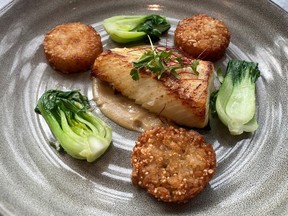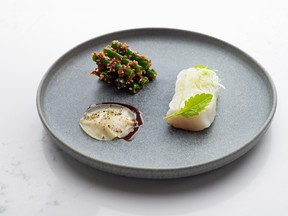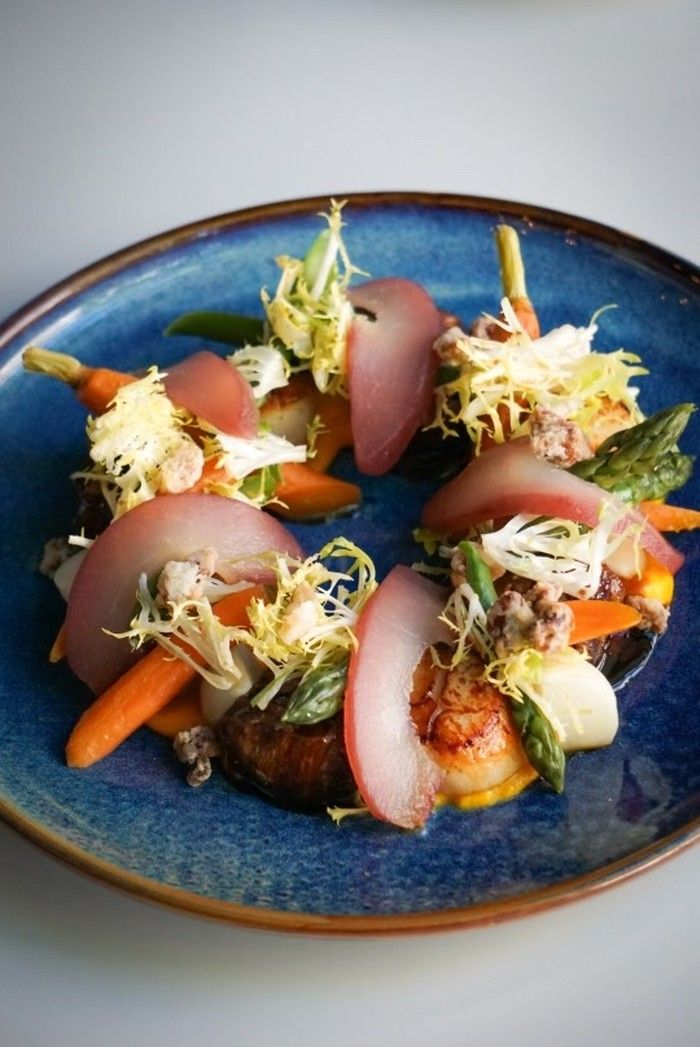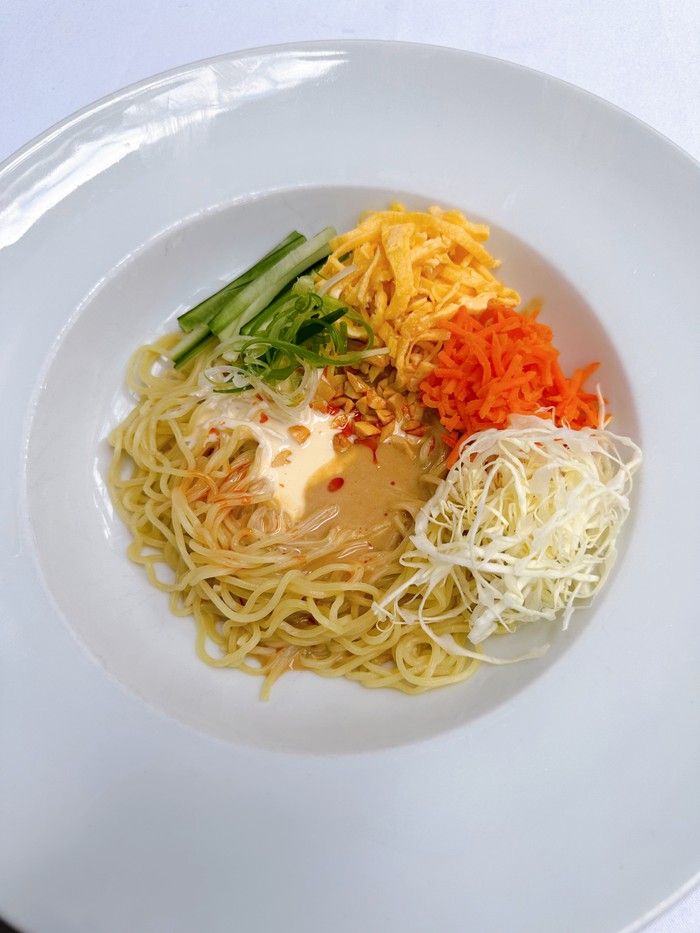Reviews and recommendations are unbiased and products are independently selected. Postmedia may earn an affiliate commission from purchases made through links on this page.
Asian Heritage Month: Vancouver chefs share 5 favourite recipes

Celebrate Asian Heritage Month with these five flavourful recipes.

Article content
May is Asian Heritage Month, a time to celebrate the diverse cultures of Asian communities across Canada. The theme for this year’s Asian Heritage Month is “Preserving the Past, Embracing the Future: Amplifying Asian Canadian Legacy.”
And one amazing way to do that is through food. In honour of the month, we’ve rounded up five recipes shared by Vancouver chefs to showcase just a few of the fantastic flavours that can be found throughout the vast landscape of Asian cuisine:
Advertisement 2
Article content
Article content

Steamed B.C. line-caught Pacific ling cod with ginger, chili crunch green beans and tofu congee dumplings
Recipe by: Head Chef Lian Cosby, Blue Hat Bakery-Cafe & Bistro at the Pacific Institute of Culinary Arts.
Ling cod
1 lb (454 g) Pacific ling cod, divided into equal 4 portions
2 tbsp (30 mL) ginger, skin removed and thinly sliced into batons
Salt & pepper
Chili green beans
1 lb (454 g) green beans (yard-long beans, if available), cut into 2-inch pieces
7 oz (200 mL) chilli oil
2 tbsp (30 mL) fermented shrimp paste
1 tbsp (15 mL) shredded dried scallops
In a small bowl add chilli oil, fermented shrimp and shredded scallops. Set aside.
Put banana leaf into the bamboo steamer. Then place in the steamer and put into a pan filled with at least 1 inches of water.
Season fish with salt and pepper. Place into the steamer on one side. Lay batons of ginger on fish. Place beans on other side of the steamer next to the fish. Set timer for 3 1/2 minutes. Remove fish onto a resting tray.
Remove beans and toss in small bowl with the fermented chili mix. Toss well.
In a small pot boil water and cook dumpling wrapper for 45 seconds. Remove with slotted spoon and place on resting tray.
Advertisement 3
Article content
Dumplings
4 dumpling wrappers
4 oz (114 g) soft tofu
2 tbsp (30 mL) cooking oil such as canola, grapeseed, peanut, etc.
1 tsp (5 mL) shallot, minced
2 tbsp (30 mL) garlic
1 tbsp (15 mL) green onion (sliced in thin rounds, green and white)
1 tbsp (15 mL) Jasmine rice
4 dried Shiitake mushrooms, rinsed
1 cup (250 mL) chicken stock
1 banana leaf
Heat up a wok or large fry pan until almost smoking, then swirl in the oil. Add the shallots and garlic. Sauté until golden taking care not to burn. Turn heat down to low and add chicken stock, rice and dried Shiitake mushrooms.
Simmer on low until all the liquid has evaporated and the rice is breaking apart. Remove from heat and transfer to a plate to cool.
Once cooled, remove Shiitake mushroom. Cut off stems and discard. Slice mushroom into thin pieces. Then return to mixture.
In a medium bowl, mash tofu with a fork, then add in the wok mixture along with green onions. Stir to combine. Cover with plastic wrap and keep warm.
Place fish on side of plate, scoop a tablespoon of tofu congee mix on plate and drop dumpling wrapper on top. Toss beans in bowl and place on the side of the plate.
Article content
Advertisement 4
Article content
Serves 4.
Pork belly and pears
Recipe by: Chef Tommy Shorthouse, Fanny Bay Oyster Bar & Shellfish Market.
2 lb (907 g) skinless pork belly
Belly brine
1/2 cup (125 mL) sugar
1 1/2 cups (375 mL) fine salt
1 tbsp (15 mL) ground black pepper
1 1/2 tbsp (22.5 mL) Chinese 5 spice
12 cups (3 L) water
Mix dry ingredients together. Add to 3 litres of water. Mix until sugar dissolved. Take a 2 lb piece of skinless pork belly and submerge it in belly brine. Store in brine in the fridge overnight. When ready to cook, remove and pat dry.
Scallops
16 pieces large scallops (fresh or frozen and thawed/dried)
For the scallops, ensure the scallops are patted dry and seasoned with fine salt just before cooking. To cook, place scallops into a preheated pan on high heat with neutral cooking oil and allow to cook on medium-high heat for one minute, then carefully flip and cook on other side for another 30 seconds to one minute. Remove from pan and place on paper towel to allow excess oil to drain before plating.
Optional for plating
1/2 lb (226 g) baby carrots, roasted
1/2 lb (226 g) asparagus, blanched
1/2 lb (226 g) baby Tokyo turnips (simmered and cut)
Advertisement 5
Article content
1 lb (454 g) jumbo carrot (peeled, simmered and blended into puree)
2 heads frisée lettuce, cut and rinsed
2 tbsp (30 mL) unsalted butter
Pears
1 Anjou pear
1 piece star anise
1 cinnamon stick
11 oz (310 mL) red wine (Merlot or Syrah)
2 cups (500 mL) water
1/3 cup (80 mL) sugar
With a vegetable peeler, peal the skin from the pear. In a pot over medium-high heat, add all ingredients except pears and bring to a boil. Once boiling, lower the heat and add in pears. Cover and simmer for 20 minutes or until pears have softened. Allow pears to cool. Slice and serve.
Dressing
3 tbsp (45 mL) sherry vinegar or red wine vinegar
1 cup (250 mL) olive oil
1 1/2 tsp (7.5 mL) olive oil
1 1/2 tsp (7.5 mL) honey
1 tbsp (15 mL) grainy mustard
1/2 tsp (2.5 mL) salt
Preheat oven to 300 F. Place pork belly on a baking pan lined with foil or silicon paper and a wire rack. Place the meatier portion of the belly facing down.
Roast in centre of the oven for 2 1/2 hours then remove. Place on another tray or plate. Allow to cool for 20-30 minutes. Slice pork to desired size. Option to fry and toss in a sweet soy-infused sauce made at Fanny Bay.
Advertisement 6
Article content
The final dish is plated with pan-seared scallops, carrot puree, spring butter glazed vegetables, frisée salad, spice-infused red wine poached pears and candied walnuts
Serves 2.
Taiwanese Cold Noodles (涼麵)
Recipe by: Chef Robert Lee, Glowbal Restaurant.
2-3 servings Asian noodles or ramen
Sesame sauce
4 tbsp (60 mL) sesame paste
2 tbsp (30 mL) peanut butter
2 1/2 tbsp (37.5 mL) soy sauce
1 1/2 tbsp (22.5 mL) miso
2 tbsp (30 mL) sesame oil
2 cloves garlic, grated
2 tsp (10 mL) ginger, grated
1 tbsp (15 mL) sugar
5 tbsp (75 mL) water or vegetable stock
1 1/2 (22.5 mL) rice vinegar
White sauce
6 tbsp (90 mL) Taiwanese mayo
1 clove garlic, grated
1 tbsp (15 mL) water
1 tbsp (15 mL) rice vinegar
2 tsp (10 mL) sugar
Toppings
Cucumber, julienne
Carrots, julienne
4 eggs
Cabbage, thinly sliced
Toasted peanut, crushed
Sauces
Combine the ingredients in two separate bowls and whisk all the ingredients together until well-emulsified. Downsize into smaller containers and refrigerate.
Toppings
Crack and whisk eggs in a bowl. In a nonstick pan over medium heat, add enough oil to cover bottom. Pour in just enough egg to cover the bottom of the pan. Cook until it sets, flip over and then set it aside on a tray to cool. Continue the process until all the egg mixture is used up. Once all the eggs are cool, roll the egg sheets up and cut into thin strips.
Advertisement 7
Article content
Noodles
Follow the package instructions for how long to cook the noodles in boiling water. Time varies for different types of noodles. When the noodles are done, rinse the noodles in cold water and strain excess water. Toss with a small amount of sesame oil to prevent noodles from sticking together.
Split the noodles onto desired plate and place toppings on the noodles before drizzling on both sauces. Sprinkle on crushed peanut to finish. If you like it spicy drizzle on some chili oil to add the extra kick.
Chef’s note: Taiwanese Cold Noodle is a popular street food enjoyed throughout Taiwan. The version I’m sharing is the one specifically made in Jiayi City, where my mother was born and raised. She often prepared this dish for my brother and me during the sweltering summers when our appetites waned.
Typically, Taiwanese mayonnaise is used to create the white sauce, adding a delightful tanginess and sweetness to the dish. This not only enhances the flavour, but also serves as a clever way to encourage children to eat their vegetables.
For those seeking a heartier meal, shredded chicken breast or poached prawns can be included in the dish, providing a more balanced and satisfying dining experience.
Advertisement 8
Article content
Serves 2-3.
Saikyo Miso Yaki (Sake-marinated sablefish)
Recipe by: Sushi Chef Jae Cho, The Victor.
Sablefish
5-6 oz (142-170 g) sablefish, steak cut or small fillet
Kosher salt
Saiko miso marinade
7 oz (200 g) Saikyo miso or regular white miso
1/2 oz (15 g) Sake
1 tbsp (15 g) mirin
2 tsp (10 g) sugar
Blend all ingredients until smooth texture. Set aside.
Miso puree
1/8 cup + 4 tsp (40 g) white miso
1/2 tsp (2 g) Yuzu juice
1/8 cup + 4 tsp (40 g) white sesame seeds
1/4 cup (60 g) sugar
1/3 cup + 4 tsp (100 mL) water
Blend all ingredients until smooth texture. Set aside.
Crispy sushi rice coin and blanched bok choy
Portion sable fish fillets in 6 oz size. Sprinkle salt evenly on both sides of sable fish portions. Allow to sit for 30 minutes and dry any moisture that came out.
Spread Saikyo miso marinade on sable fish portions and marinade for up to two days. Rinse marinated fish with water and dry well.
Preheat oven at 500 F. On a baking tray, bake sable fish for 6 minutes. Finish in salamander broiler until char colour on top. Smear miso puree across centre of plate. Plate with baked and broiled sable fish with bed of crispy sushi rice and bok choy.
Advertisement 9
Article content
Serves 4-6.
Shrimp toast
Recipe by: Chef and owner Chris Lam, Straight and Marrow.
Shrimp mix
2 oz (58 g) peeled ginger
5 cloves garlic
1 small can of water chestnuts
1 lb (454 g) peeled shrimp
1 tsp (5 mL) salt
1 1/2 tbsp (22.5 mL) sesame oil
1 1/2 tbsp (22.5 mL) soy sauce
3 tbsp (45 mL) corn starch
1 tsp (5 mL) white pepper
1 egg white
Dipping sauce
1/2 cup (125 mL) black vinegar
1/3 cup (80 mL) soy sauce
1/8 cup (30 mL) chili oil
1 tbsp (15 mL) garlic powder
1/8 cup + 1 tbsp (45 mL) chopped cilantro
Add all dipping sauce ingredients in a bowl and whisk together. Set aside until ready to serve.
Combine all ingredients for shrimp mix in a food processor, pulse until desired texture is reached. Spread the paste uniformly on white bread, about 1/2-inch thick, while pressing gently to ensure it sticks.
In a pan, heat about 2 cups of oil on medium-high heat. You want about 1/2 inch of oil in the pan. Cook the toast paste-side down for about 2-3 minutes before flipping to the bread side for another 1-2 minutes or golden brown. Drain onto paper towel.
Serve with dipping sauce.
Serves 6.
Recommended from Editorial
Bookmark our website and support our journalism: Don’t miss the news you need to know — add VancouverSun.com and TheProvince.com to your bookmarks and sign up for our newsletters here.
You can also support our journalism by becoming a digital subscriber: For just $14 a month, you can get unlimited access to The Vancouver Sun, The Province, National Post and 13 other Canadian news sites. Support us by subscribing today: The Vancouver Sun | The Province.
Article content
Source: vancouversun.com







